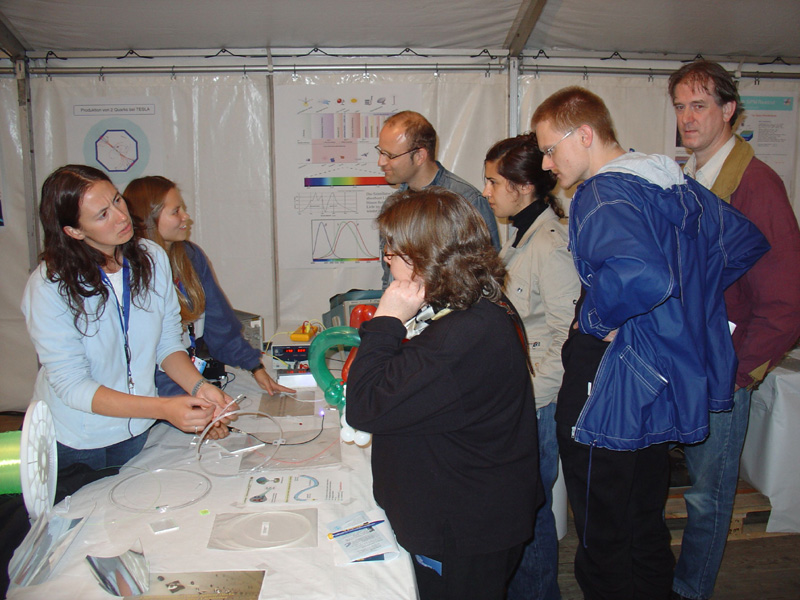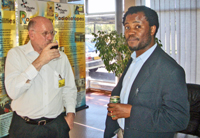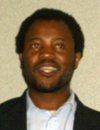 |
|
|
 |
DESY Opens Doors for First Hamburg Science Night
Last Saturday night, on October 29th, the first "Science Night" took place in Hamburg, Germany. All major research organizations and universities opened their doors for a night full of science. A shuttle service with 8 different bus lines and one boat line connected places all over town between 6:00 p.m. in the evening until 1:00 a.m. on Sunday morning.

DESY scientist Erika Garutti (left) and diploma student Nanda Wattimena are explaining the optical readout of the scintillating tile hadronic calorimeter of the ILC detector to visitors.
|
DESY participated with an exhibition, which was placed around the VUV-FEL at the TESLA Test Facility TTF. All research areas at DESY, including accelerator research, research with photons and High Energy Physics research participated with exhibitions containing posters, hands-on experiments, talks, games and a lot of fun. Special emphasis was put on introducing the European XFEL project to the public.
A focal point of the DESY exhibition was superconducting RF which will be used for the European XFEL and the International Linear Collider. Visitors learned a lot about superconductivity, such as trying to understand how a model railway with a high-TC superconductor carriage was able to levitate above its track.

Oliver Schaefer from Rostock University is explaining the method of linear acceleration to these visitors at 12:30am in the morning.
|
The physics opportunities of the ILC were presented in a dedicated exhibition with the name 'Back to the Big Bang'. Physicists, engineers and students of the HEP research groups of DESY together with guest scientists spent the better part of the night explaining to visitors the benefits of scattering experiments, how a cloud chamber works, and of course the connection of the smallest particles and the fate of the universe. In addition, a glimpse into the life inside the laboratories was given by presenting the research ongoing on ILC related detector R&D efforts at DESY with a lot of hands-on examples.
The DESY event was accompanied by a carefully designed illumination of the DESY installations around the visitor's paths. The DESY halls and buildings were glowing in blue and red, giving the whole nighttime event a spectacular appearance.
Read more
--Karsten Buesser
|
 |
|
|
 |
Upcoming meetings, conferences, workshops
Damping Rings Meeting
CERN, Switzerland, 9-11 November 2005
ECFA ILC Workshop
Vienna, Austria, 14-17 November 2005
CARE 05
CERN, Switzerland, 23-25 November 2005
TESLA Technology Collaboration Meeting
Frascati, Italy, 5-6 December 2005
GDE Meeting
Frascati, Italy, 7-10 December 2005
American Linear Collider Physics Group - Detector Simulation Workshop
Colorado, U.S.A., 9-11 January 2006
2006 LCWS 2006
Bangalore, India, 9-15 March 2006
International School for Linear Colliders
Sokendai, Graduate School for Advanced Studies
Hayama, Japan, 19-26 May 2006
|

SLAC Director Jonathan Dorfan and Zeblon Vilakazi, of iThemba Laboratories, at the reception following a seminar and discussion on the ILC at the laboratory, which is near Cape Town, South Africa.
|
|
 |
 |
|
|
 |
European GDE Members Hold First Meeting, Address Questions about the Future

Brian Foster addressing the EGDE Meeting attendees in the Fisher room at Oxford University at the close-out talk at the end of the day.
|
On 25 October, the European GDE members met at Oxford University to discuss serious questions about the future of European Union funding and the status of European R&D. In between talks, attendees were treated to a traditional Oxford tea.
After in-depth discussions, Brian Foster, Regional GDE Director for Europe, decided to appoint a small executive group to consider the shape of the Framework Programme 7 (FP7) bid. (The FP is the EU's main instrument for research funding in Europe. FP7 will cover a period of seven years and should start in 2007). Foster will discuss the appropriate strategy with the ECFA chair and the representatives of the other candidates for large-scale European funding. Every participant at the meeting agreed that prototyping and industrialisation should have important roles in the next programme.
The industrialisation process is already underway at DESY, with the preparation of XFEL and push for SCRF R&D linac technology. "The XFEL R&D in Europe overlaps a lot with the ILC, and there is a room for interplay in the ILC activities", said DESY physicist and GDE Deputy Director Nick Walker. Except for the gradient, the two machines are actually very similar from the cavity point of view. "Nevertheless", said Walker, "high-gradient studies remain part of the XFEL programme". (Next week, ILC NewsLine will report on the Foundation Meeting for the European SCRF Forum, which took place on 27th October)
Discussions at the meeting also focused on the role of the Tesla Technology Collaboration (TTC) and the ILC. "To get the momentum to put Europe at an important place for superconducting rf work", said Carlo Pagani, of University of Milano and INFN, "The Tesla Technology Collaboration would be a good container". The TTC could play a role in the ILC by preparing a request to the EU for funding a new generation SRF Infrastructure in Europe. EGDE members acknowledged the importance of the TTC, but they also recommended that clear plans and responsibilities be outlined to determine its future role in the field of particle physics. "Otherwise, the container will stay empty." said Pagani.
Reports from national programmes, namely from DESY, CERN, France, Italy, UK, and Russia were also presented at this first EGDE meeting. "Optimisation of the current R&D strategy should be undertaken at the same time as we look to future funding possibilities", said Foster. He also stressed the need for the excellent human resources available in Russia to be fully engaged in the ILC project.
Toward the end of the day, the EGDE dedicated a part of the meeting to discussing GDE communication activities and future plans in Europe. "It will be proposed to the next Restricted ECFA (RECFA) meeting in December that the current European Linear Collider Study Group [ELCSG] Outreach Subcommittee should be transferred to the GDE", said Foster. The question of funding to translate certain strategic communication documents, such as a short brochure about the ILC, was also raised.
--Perrine Royole-Degieux
View more photos from the meeting.
All of the talks from the meeting are available online.
|
 |
|
|
 |
From Interactions.org,
2 November 2005
Oundle School: Superstrings and violin strings
In an unique and stimulating double event, Oundle pupils and staff were treated to an exploration of the life of Albert Einstein and his defining contribution to our understanding of how the universe works.
Read more...
From CERN Courier,
November 2005
Barish presents plans for the ILC
The schedule of the Global Design Effort (GDE) for the future International Linear Collider (ILC) was an important topic at the meeting in September of CERN's Scientific Policy Committee.
Read more...
From Fermilab Today,
3 November 2005
Community Group Discusses International Linear Collider
Members of the Fermilab Community Task Force on Public Participation met Tuesday evening to discuss issues related to the proposed International Linear Collider, and its potential impact on Fermilab and the community.
Read more...
|
|
 |
 |
|
|
 |
Cape Town
Last week, I visited Cape Town, South Africa with Jonathan Dorfan, a native of Cape Town, and Shin-ichi Kurokawa. For different reasons, each of us participated in the 25th General Assembly of the International Union of Pure and Applied Physics (IUPAP) on 25-28 October 2005. Just to remind you of the relevance of IUPAP to the ILC and GDE, the International Committee for Future Accelerators (ICFA) is a working group of IUPAP and it was ICFA and its subcommittee (ILCSC) that conceived of and formed the GDE, as well as appointed me as Director. In a real sense they are my bosses, and the GDE is accountable to and reports to the ILCSC and ICFA.
IUPAP is the highest level international body made up of physicists representing the different countries and it seems evident that the role of IUPAP will become more and more important as physics of all types becomes more international. High Energy Physics has led the way toward internationalizing, but now it is becoming the case for many other subfields of physics. One of the main roles of IUPAP is to sponsor international conferences and they set guidelines to make certain that the mix of speakers and participants represent the world community. In particle physics, IUPAP sponsors both the Lepton-Photon Conference (held in Uppsala last summer) and the International Conference on High Energy Physics (to be held in Moscow next summer). Another role of IUPAP is to facilitate and coordinate international cooperation and collaboration in physics, and it is through ICFA that this role is being filled for the ILC.
As the chair of ICFA, Jonathan Dorfan came to the IUPAP General Assembly to give a report on the activities of ICFA. Shin-ichi Kurokawa came to Cape Town as the Japanese representative to the Commission of Physics for Development (C13), and I came as chair of the US delegation to the General Assembly. I was also invited by the President of IUPAP to give a talk to the General Assembly on the ILC, since it represents the largest international project being developed. Jonathan's ICFA talk and my ILC talk were back-to-back and both were very well received by this truly global forum of physicists.
Highlights of the IUPAP General Assembly included a very informative presentation on the visa situation, especially for the U.S, by Vera Luth of C-11 (commission on particle and fields). An important outcome for us at this General Assembly is that they voted to renew ICFA for another three years, meaning that we haven't lost our parent body. Finally, a high energy physicist, Alan Asbury of Canada has become the new President of IUPAP for the next three years.

Zeblon Vilakazi
|
Jonathan, Shin-ichi and I took a very interesting and potentially important side trip to visit iThemba Laboratories. IThemba is a sizeable laboratory near Cape Town that is devoted to Accelerator Based Sciences. We were hosted by Dr. Zeblon Vilakazi, who arranged for us to give a well attended special seminar and discussion on the ILC on very short notice.
Read more
--Barry Barish
Director's Corner Archive
|
 |
|
|
 |
Last Chance to Register for the TESLA Collaboration/ GDE Meeting, 5-10 December 2005
Information about the TESLA Collaboration meeting and the next GDE meeting is now available online. The registration and hotel reservation deadlines are 5 November 2005.
Proposals for detector R&D
The LCSGA is now soliciting proposals for university-based detector R&D projects
in the U.S. in support of the ILC.
More information
Proposals for accelerator R&D
The ILC GDE is soliciting proposals for university-based accelerator
R&D projects, within the Americas region, in support of the ILC.
more information
ILC Related Preprints
hep-ph/0510335 - Basics of a photon collider, 28 Oct 2005
hep-ph/0510395 - Study of the single neutral top-pion production process at gamma gamma collider, 29 Oct 2005
hep-ph/0510399 - Branon radiative corrections to collider physics and precision observables, 30 Oct 2005
hep-ph/0510420 - TeV-Scale Black Holes in Warped Higher-Curvature Gravity, 31 Oct 2005
|
|

